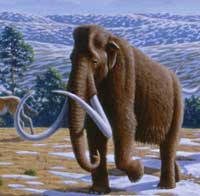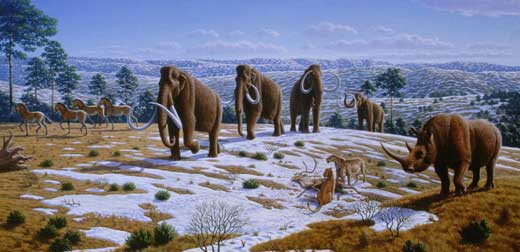What killed the woolly mammoth? Understand article
Climate change is nothing new. Caitlin Sedwick describes how a computer model is helping scientists to explain the extinction of the woolly mammoth.

Image courtesy of Mauricio Anton;
image source: Wikimedia commons
Forty-two thousand years ago, during the last glacial advance of the Pleistocene epoch, woolly mammoths thundered across the frozen steppes of the Eurasian continent. The huge beasts thrived on the arid tundra of the last ice age, having adapted to temperatures that would chill the toes off any hairless ape. Yet, by the middle of the Holocene epoch, 6000 years ago, the glaciers had retreated and the Eurasian woolly mammoth was on the verge of extinction. They were ultimately done in, say David Nogués-Bravo and colleagues, by climate change – with a helping hand from humans.
Ever since Mikhail Adams retrieved the first fossilised woolly mammoth remains from Russia in 1806, scientists have debated what happened to this ancient relative of the Asian elephant (Gross, 2006). Did it die out because its habitat disappeared, as the planet’s climate warmed and vegetation and precipitation patterns changed? Or did human interlopers on the Eurasian plains hunt it to extinction? It’s a difficult question to untangle, because the retreat of the glaciers at the end of the Pleistocene era not only changed the animals’ habitat but also allowed primitive human bands to migrate north from southern Eurasia, probably hunting whatever game they encountered during their journey. Whereas previous attempts to explain what happened to the mammoths were largely descriptive inferences based on available data, Nogués-Bravo et al (2008) used the data to generate quantitative estimates of the interplay between the mammoth’s disappearing range and warming versus hunting.
To study the factors that may have contributed to the mammoth’s demise, the authors modelled the climate in the regions inhabited by the mammoth during several periods of the last ice age. Their model related the fossil record – showing the distribution and age of mammoth remains – to simulated maps of the highest mean temperature, the lowest mean temperature, and average rainfall conditions on the Eurasian supercontinent for three periods during the last glacial advance in the Pleistocene (42 000, 30 000, and 21 000 years ago) and to a point in the interglacial in the middle of the Holocene era (6000 years ago). Next, they applied their climatic models to the Eurasian supercontinent 126 000 years ago (the previous time the planet had warmed between glacial advances). Together, these data allowed the group to estimate the characteristics and extent of the animals’ favoured habitat at the periods studied.

Image courtesy of Mauricio Anton; image source: Wikimedia commons
The authors’ findings suggest that mammoths experienced a catastrophic loss of habitat: as the last glaciers retreated and the planet warmed, 90% of the animals’ former habitat disappeared. Prime mammoth habitat progressively shrank from 7.7 million square kilometres 42 000 years ago (in the midst of the last glacial advance) until just 0.8 million square kilometres remained 6000 years ago. The animals were restricted to isolated tracts spotted across Eurasia and tiny patches squeezed up against the northern coastal edges.
Although the near obliteration of their habitat would have placed great pressure on the species, the situation appeared even more dire during the previous glacial retreat 126 000 years ago, when only 0.3 million square kilometres of prime habitat existed. At that time, the species probably teetered on the brink of extinction, as geographically isolated groups experienced declines in genetic diversity and fitness. Even so, the mammoths had managed to survive that crucible. What was different about the Holocene? The remaining mammoth herds faced a foe that hadn’t existed 126 000 years ago: human hunters.
Humans evolved to their modern form during the Pleistocene and migrated north with the final retreat of the glaciers, hunting mammoths as they advanced. By the middle of the Holocene, mammoth populations were so vulnerable that it would not have taken much hunting pressure to push them to extinction. The authors’ most optimistic estimates of mammoth population size and density suggest that if each human killed just one mammoth every three years, the species would become extinct. More pessimistic estimates suggest that the loss of as few as one mammoth every 200 years (per human in its territory) might have sealed the animals’ fate.
Other evidence may yet be uncovered that would support the authors’ contention that mammoth populations made vulnerable by climate change were finished off by human hunting. For example, the authors’ habitat models suggest new areas on the Eurasian continent where mammoth fossils may be found. Expeditions to these locations could determine whether mammoth populations lived there, and provide more evidence to help researchers continue the shift from qualitative to quantitative interpretations of the data.
This article was first published in PLoS Biology and is reproduced with kind permission.
References
- Gross L (2006) Reading the evolutionary history of the woolly mammoth in its mitochondrial genome. PLoS Biology 4(3): e74. doi:10.1371/journal.pbio.0040074
- Nogués-Bravo D et al (2008) Climate change, humans, and the extinction of the woolly mammoth. PLoS Biology 6(4): e79. doi:10.1371/journal.pbio.0060079
Web References
- w1 – For details of the film Ice Age, see the Internet Movie Database: www.imdb.com/title/tt0268380
Resources
- For more accurate accounts of the decline of mammoth populations than is provided in the film Ice Age, see two BBC TV documentaries:
- The last episode of Walking with Cavemen. See the Internet Movie Database: www.imdb.com/title/tt0370053 and the BBC website: www.bbc.co.uk/sn/prehistoric_life/tv_radio/wwcavemen
- Walking with Beasts. See the Internet Movie Database: www.imdb.com/title/tt0286285 and the BBC website: www.bbc.co.uk/sn/prehistoric_life/tv_radio/wwbeasts
- A very good BBC Radio 4 programme on the fate of mammoths can be heard online. See: www.bbc.co.uk/radio4/science/frontiers_20020515.shtml
Review
When the summary of a scientific paper is written in such a pleasant, simple and friendly way, it is an excellent teaching resource for a natural science or English-language teacher. It can be used in secondary schools by biology and earth science teachers, who can exploit it in an interdisciplinary way, possibly involving the English-language teacher in a CLIL activity (a European project aimed at teaching different subjects in a foreign language).
The topic is interesting for every student who remembers the film Ice Agew1, the style is witty and precise at the same time, and the logical development of the text is easy to follow. Moreover, the article content is a perfect example of the scientific method at work (observation à modelling à prediction) in the context of evolution.
Teachers could use the article to discuss climate change in geological eras and in the last two centuries, as well as methods of modern climatology and palaeontology. The article can also be used to link history and scientific subjects (earth science, biology, mathematics) for an interdisciplinary approach to the study of prehistory and cultural evolution.
The language of the article is plain enough to propose some comprehension questions such as:
Eurasian woolly mammoths became extinct about:
a) 126 000 years ago
b) 42 000 years ago
c) 21 000 years ago
d) 6000 years ago.
What happened 126 000 years ago?
a) the Earth’s climate became warmer
b) the glaciers retreated
c) woolly mammoths flourished in Eurasia
d) modern humans hunted woolly mammoths.
David Nogués-Bravo and his colleagues:
a) first discovered fossilised woolly mammoths
b) made descriptive inferences about the woolly mammoths’ extinction
c) built mathematical models of climate changes in the last ice age
d) are going to unearth fossils in the Eurasian continent.
The reading activity could be completed by building a geological timeline with the students (I performed an activity like this with a toilet paper roll in the school courtyard: every sheet of the paper symbolised a certain time period).
Finally, the article has a format that is easily handled by teachers and it is a good starting point for further activities in the exciting field of Earth’s history. The format is suitable for a single lesson.
Giulia Realdon, Italy





